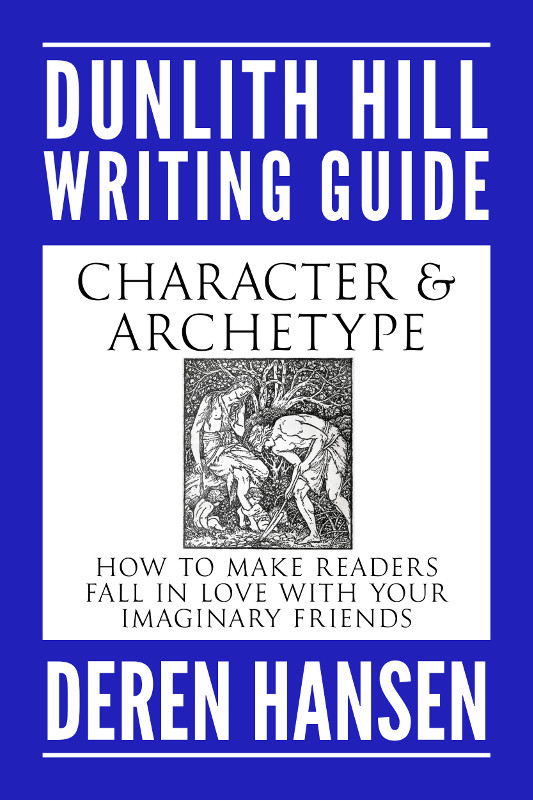
Description
One inescapable fact about our species is that we’re social animals: people are at the center of our universe. We have a long history of trying to understand the natural world by personifying its aspects. That’s why believable characters make or break our stories.
A novel, however, is not a portrait. What readers really want is to see how interesting characters act and transform themselves over the course of your story.
This guide explores the structural underpinnings of character and characterization in terms of mythic cycles of transformation like the Hero’s Journey and the Virgin’s Promise. Once you understand these patterns your characters will ring true and your readers will believe in them, too.
Purchase
Chapter 1: Strength of Character
I must confess, though I’ve tried many times, that I like fantastic stories better than contemporary ones. Given that stories of the fantastic are usually not at the top of the list for careful character studies, it is, perhaps, not the most auspicious way to start a guide to character and archetypes. But trying to figure out why I prefer fantasy is what led to the study you now hold.
At first I feared I was simply too judgmental of characters in familiar situations. In a contemporary story it’s easy to question the choices characters make when you can think of alternate courses of action. In a fantasy, where the rules are different, it’s harder to second guess the characters. The issue, however, is deeper than characters doing things with which you don’t agree: the story falls apart if a reader can think of other, simpler ways to solve the story problem. For example, there are a great many romances in which the couple is kept apart at some point by a misunderstanding that could be resolved with a five-minute conversation.
Regardless of the setting, whether fantastic or realistic, in order for your characters to ring true, readers must believe their actions are natural and inevitable. Readers fold every bit of character information you give them into a mental model. Behavior which reinforces the model feels natural. Behavior which extends the model feels inevitable. In a context with which readers are familiar enough to imagine alternatives, you’ve got to take greater care to establish why your characters wouldn’t or couldn’t behave differently.
Another difference I noted between fantastic and realistic stories is the relative degree of activity and passivity. In one well-reviewed and highly recommended contemporary novel, much of the interaction takes place while the characters are hanging out. Fantastic stories tend to have a lot less hanging out because the characters are trying to do something—to get someplace, find something, or unravel a mystery. Contemporary stories are often about making one’s way in society by finding friends and fitting in. Fantasy is almost never about fitting in, it’s about being extraordinary.
You might rightly point out that my view of narrative activity and passivity is subjective and argue that characters trying to understand themselves and their place in a complex world are every bit as active as heroes battling villains. I am guilty as charged: I prefer stories which entertain the possibility that we might be wonderful over those whose fundamental world view is that life is something to be endured and which, at best, offer the hope that we might cope.
But again, there’s something important here that goes beyond my entertainment preferences. Story is about change over time. In character terms that means story is about people who do interesting things—who engage life and the world around them—and who reveal their character through their actions.
Strong Characters
If we’re supposed to cheer for the hero and hiss at the villain, why is the bad-guy often the strongest character in the story?
Good antagonists, of course, believe they are the hero of their own story. On the strength of that conviction, they act. Their actions harm or threaten the hero, which sets the story in motion. The protagonist usually spends the first half of the story reacting because the antagonist has the initiative. We learn about each character through the things they do, but we learn more from actions than reactions—which is important insofar as the antagonist is concerned because we need to understand his or her character well enough to side with the protagonist.
So what makes a strong character?
First, character is what makes a person interesting. Someone who has no opinions, interests, or aspirations—who exists in perfect compliance—isn’t interesting. An interesting character has their own view and agenda, and they make their own decisions.
Second, character is the sum of a person’s actions over time. We often fall into the error of reducing character to the initial description and first impressions. While a person’s appearance may provide some evidence of their character, we come away from a single meeting with nothing more than a caricature of them. It’s only after we’ve observed their behavior in different times and places that we understand them well enough to predict how they’ll react in a new situation.
It’s easy to get confused when we talk about strong characters because when we describe someone in real life as a, “strong character,” we often mean that they’re overbearing or obnoxious. Strong characters in narrative are simply interesting people whose actions give us insight into who they are.
Strong Female Characters
Strength, particularly physical strength, is generally a male attribute. What do we mean by, “strong,” when we’re talking about female characters?
For reasons ranging from biology to culture, the ways in which men and women can or are expected to show strength differ. That said, the things that make a strong female character are the same things that make a strong male character: a sense of purpose and the will to act.
Viewed in this light, strength of character and femininity are perfectly compatible. Most women may not be able to go toe-to-toe with the men in a barroom brawl, but they often exceed the males in the quiet, daily kind of strength. Similarly, women often show strength by drawing together a society who can collectively solve a problem instead of attacking it head-on. And unlike men who equate vulnerability with weakness, women are often strongest when they acknowledge their vulnerabilities.
Persistence in the face of opposition is a common sign of strength of character. A person who states a position and then changes his or her mind when someone counters with a contrary opinion is a weak character. A strong character has courage, in the particular sense that they don’t give up easily—not because they’re pig-headed, but because they know what they believe and why they believe it.
Strength of character is never measured on an absolute scale. It’s only meaningful in light of a character’s weaknesses. That a strong, healthy man who is versed in combat steps up to fight reveals less about his character than a physically weaker woman reveals about hers when she does something similar.
The best strategy is to approach each character, regardless of gender, as an individual with their own mix of strengths and weaknesses.
Choices Reveal Character
Fiction requires one more thing of strong characters: they must be problem solvers. It may sound like the pinnacle of courage when the black knight stands on the bridge and declares, “None shall pass!” but you don’t have a story if no one wants to pass and he’s simply standing guard. Strong characters try things, fail, learn from their experience, and try again. And in doing so, they show us what they’re made of.
The best way to show strength in narrative is to give the character two choices. If a character has consistently chosen safety over conflict during the course of a story, and if at the end they are offered a safe and honorable way out, the fact that they stay and fight says a great deal more than if they are simply cornered and have no choice.
* * *
There is, of course, much more to creating strong characters.
In the next chapter, we look at the techniques of natural characterization.
Chapter three focuses on character dynamics: the hierarchy of needs that motivate characters and the universal human pattern of reactions.
Beyond simply being active and interesting, the most compelling characters transform themselves over the course of a story. Through their experience we come to a better understanding of our own transformations. The majority of this book is dedicated to a study of the two archetypical patterns of transformation: the hero’s journey in chapter four and the virgin’s promise in chapter five.
We turn to romance in chapter six, and conclude, in chapter seven, with an approach to unifying character and plot.
But if you get nothing more from this book than the understanding that strong characters have a sense of who they are, what they want, and what they’re willing to do—that above all are active—you’ll improve your writing by an order of magnitude.
Table of Contents
1: Strength of Character |
||
2: Natural Characterization |
||
3: Character Dynamics |
||
4: The Hero’s Journey |
||
5: The Virgin’s Promise |
||
6: Romance |
||
7: The Grand Unification of Plot and Character |
Additional Resources
About the Author
Deren Hansen
Trained as an anthropologist, engineer, and historian, Deren Hansen brings a unique structural perspective to the conversation about writing and the writing life.





